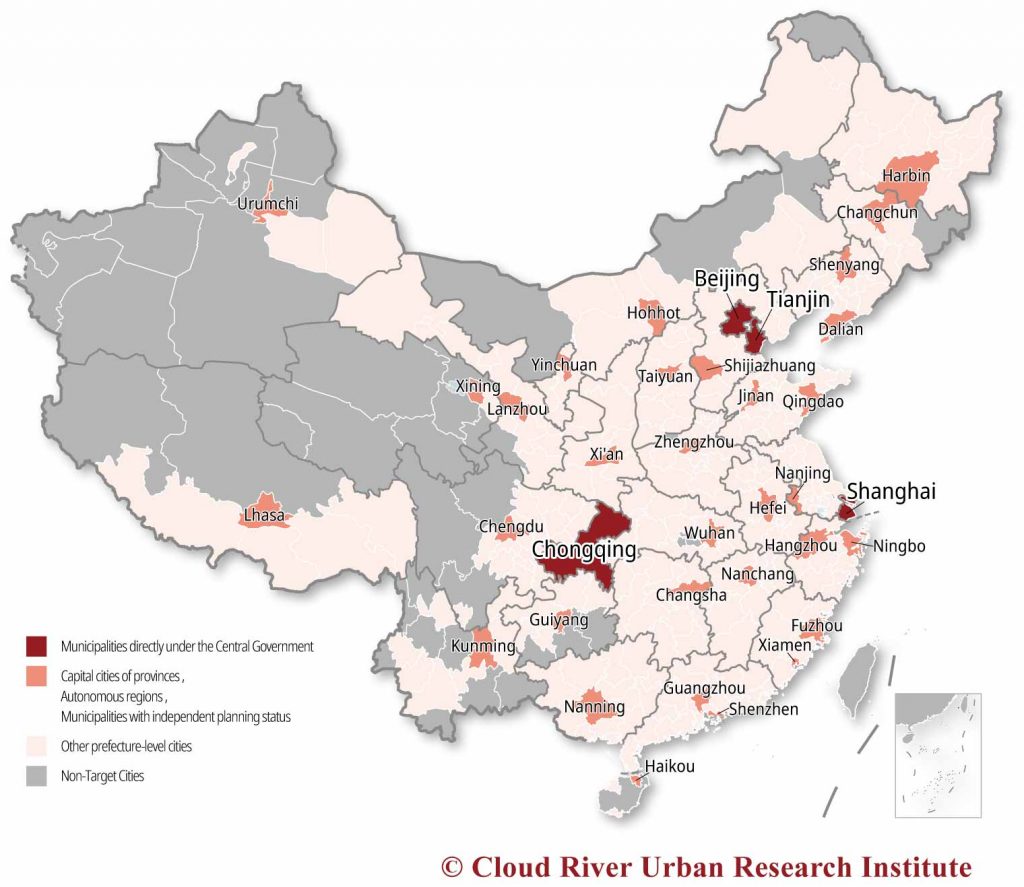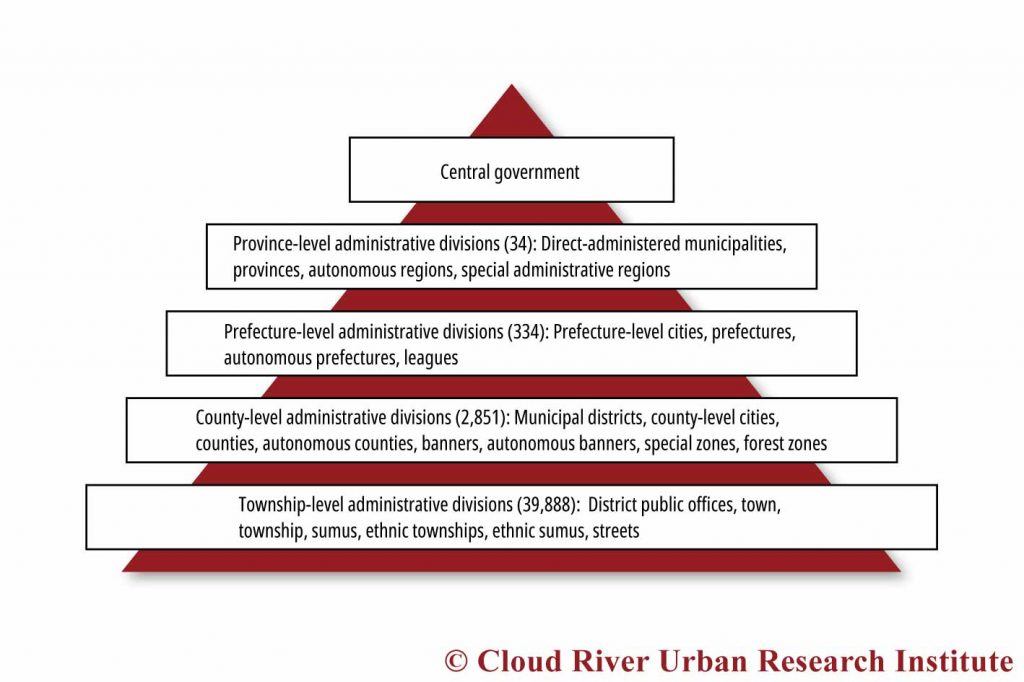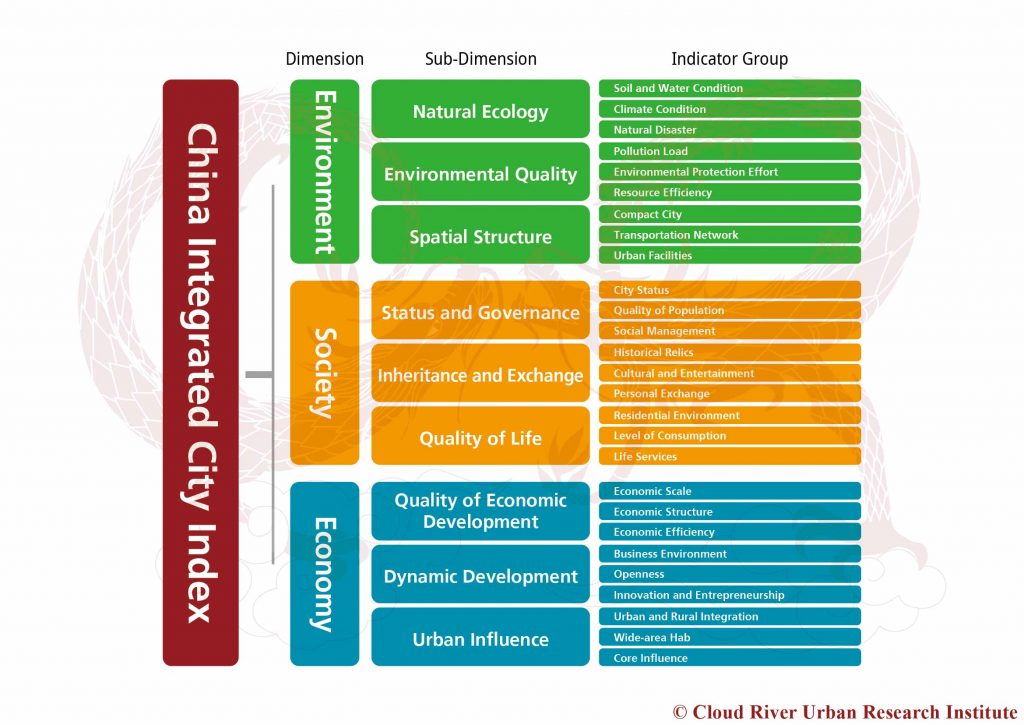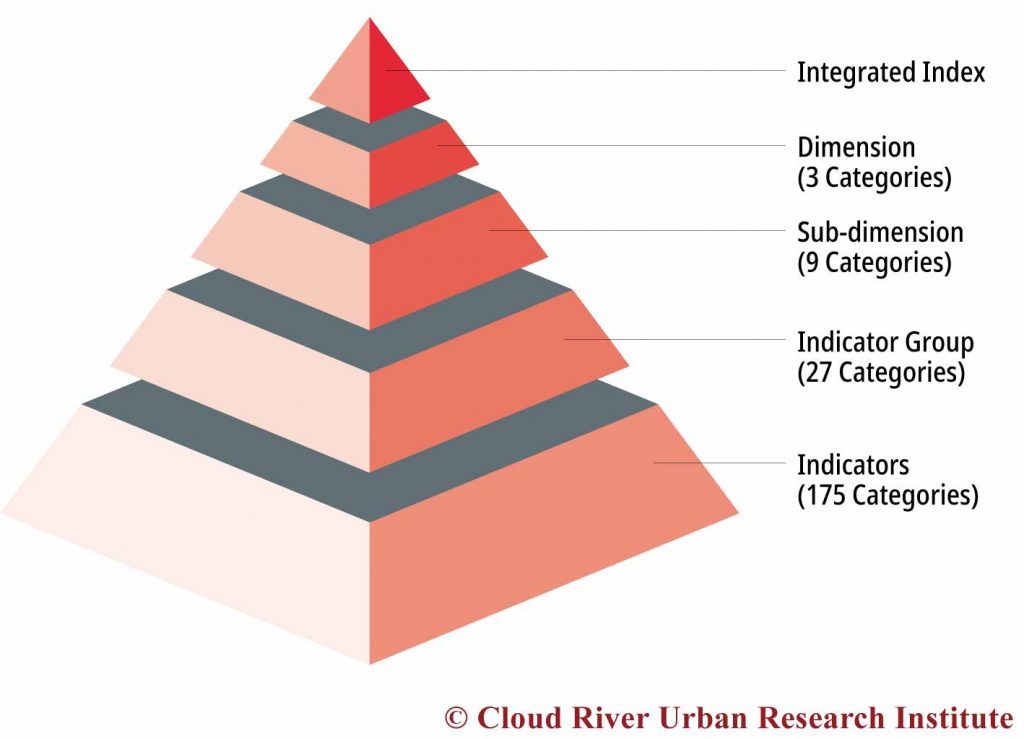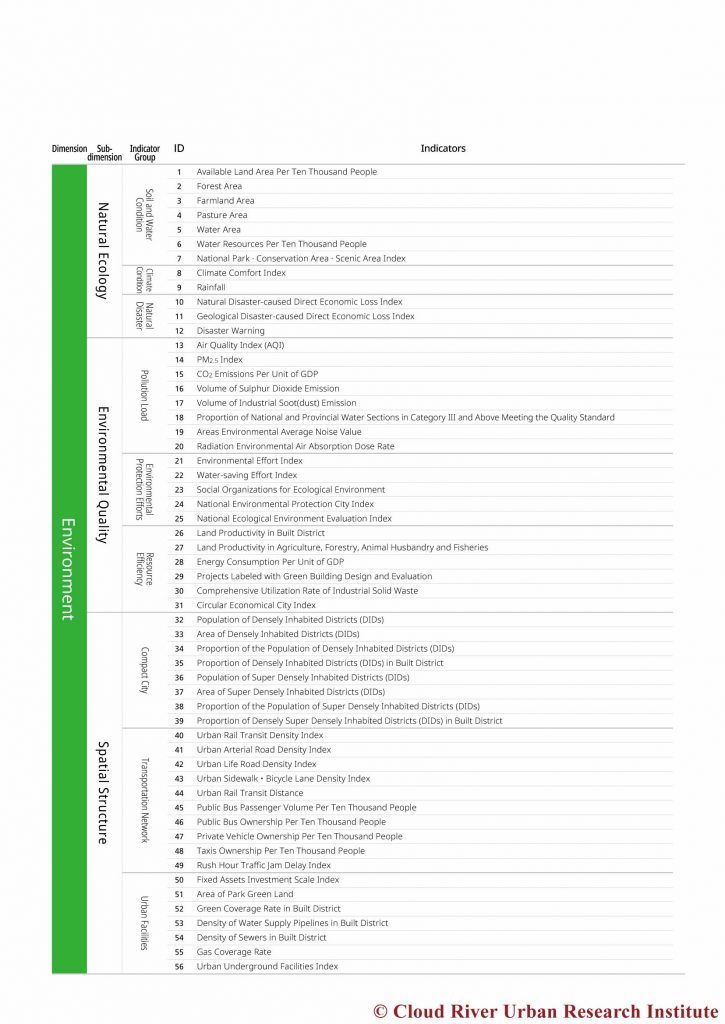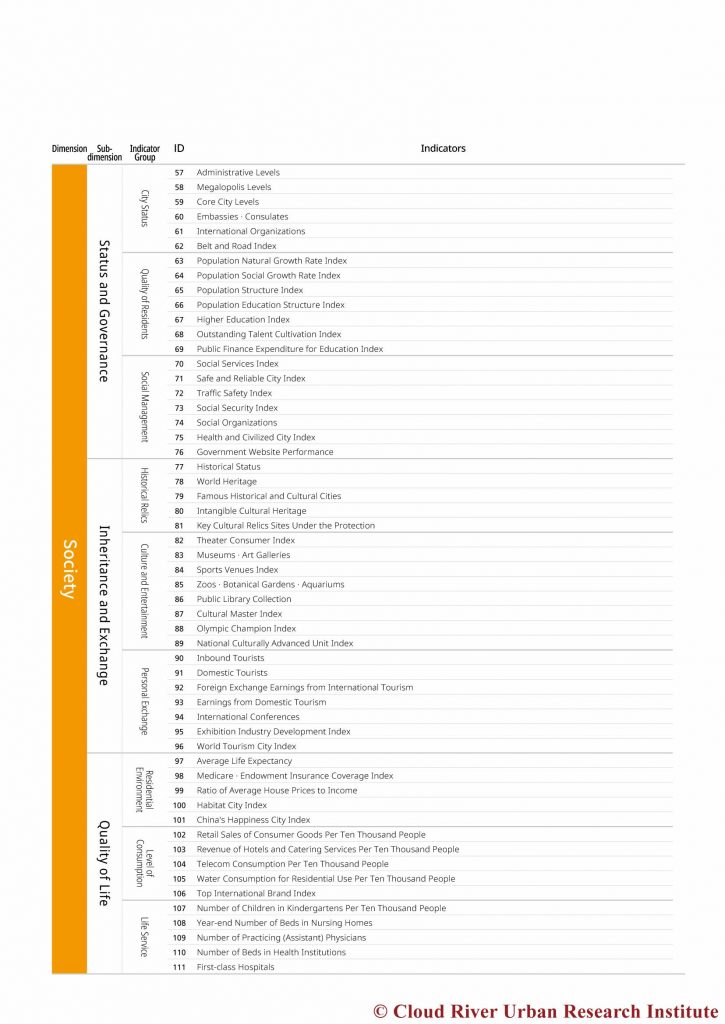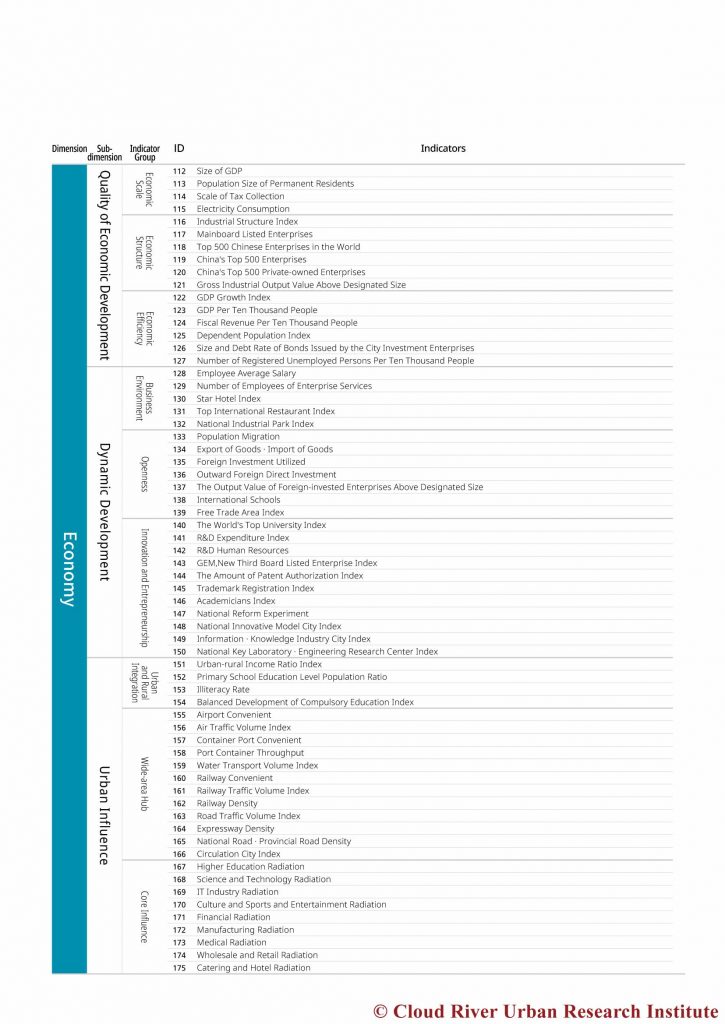1. About “China Integrated City Index”
Zhou Muzhi
President of Cloud River Urban Research Institute,
Professor of Tokyo Keizai University, Ph.D. in Economics
The 40 years of reform and opening-up has witnessed the astounding growth of China and her leap to the second largest economy in the world. However, the general competition that encourages blind pursuit of GDP indicators by individual cities, the most important element of China, has triggered serious urban issues such as environmental pollution, the widening gap between the rich and the poor, frequent occurrence of social problems, traffic congestion, and inconvenient living, to name but a few.
In response to such a situation, the Department of Development Planning of National Development and Reform Commission or NDRC, the competent authority in charge of China’s urbanization policies, has worked with the Cloud River Urban Research Institute to develop the China Integrated City Index (hereinafter referred to as “the Index”) that provides a comprehensive evaluation of cities in terms of environmental, social and economic dimensions. The Index attempts to guide cities to look for more charming and sustainable development by changing the way cities are evaluated in China, from the traditional purely GDP-based approach to an integrated one.
As the subject matter of our study, Chinese cities are very difficult to be observed. However, after an extended period of research and development, the Index has reached 298 cities across China, including all the cities of prefecture level and above, providing a multi-angle and three-dimensional comprehensive analysis and evaluation for each of them. At the same time, by taking into account the information of all these cities, the whole China has been successfully analyzed by a range of indicators. The Index has also managed to visualize the vast information by way of illustrative presentation. What is more important, China under the socialist market economy works with a unique logic, a considerable part of which is difficult to understand for the outside world. The Index measures Chinese cities by using globally accepted logical standards, to present to the world a China and her cities that are understandable and real.
The Index has been released once a year since 2016, for publication in both China and Japan, which brings a profound impact both at home and abroad. Going forward, researchers from all over the world are expected to use the Index as a primary source of information, to elevate their China study to a higher level. Therefore, the release of an English version of the Index is of great practical significance.
As the major theme of a modernizing China, urbanization is not only the engine that drives China’s economic growth, but also has become the prime power behind the transformation of China’s economic and social structures. So to speak, urbanization has opened up intense, rapid, and inevitable economic and social changes that are unprecedented to the Chinese society.
Urbanization as a process of major changes requires forward-looking high level considerations and designs, involving the re-examination and reform of institutional mechanisms such as the fiscal and taxation system, the household registration system, and the social security system. Unfortunately, however, as compared to the aggressive wave of urbanization, China’s research and discussions on the top-level design of urbanization is still scarce.
In addition, the defects in urban planning systems and construction mechanisms also have a negative impact on urban development. Planning is very important to a city. Unplanned urban space would end up a nightmare, so would poor urban planning. A city needs good rules of planning and design to regulate the participation of a variety of social capital. Only by adding and aggregating planned and regulated investments can we develop high-quality urban space and continuous urban competitiveness, whereby prime urban life can be organized.
Urban planning should be a long-term strategic consideration for the integration of resources in an area, but China’s current planning mechanisms do not support such positioning. Due to the excessive fragmentation of planning relevant to the urban development in China, there are different authorities to manage the development planning, urban planning, land use planning, transportation planning, environmental planning, and industrial planning. These authorities are in their own interested positions which prevent them from being well inter-coordinated. As a result, they are often disunited by their respective crave for political and investment achievements. This is responsible for the issues common to Chinese cities, such as the unreasonable spatial layout, unmatched transportation arrangements, inconvenient lives of urban residents, and deterioration of the quality of ecological environment.
All in all, the last round of urbanization in China, whether viewed from a macro or micro perspective, involved much less brainstorming on mechanisms, systems and planning as compared to a large amount of practices in other countries. One of the key reasons for this fact is the inability to analyze and manage data. Advanced ideas and frameworks have been continuously introduced for policy-making in recent years, including principal functional zones and new urbanization, to provide novel thoughts and directions for China’s spatial development and urbanization. The next step will be focused on how to embody these policies, as well as how to evaluate and supervise the implementation and execution of policies and plans.
To that end, the Department of Development Planning of NDRC has worked with the Cloud River Urban Research Institute to compile and publish the Index, a quantifiable and visualized system for the evaluation of urbanization indicators, setting up a suite of “digital benchmarks and frames of reference” for the urbanization of China.
The Index is designed to assist with policy-making and planning by means of advanced philosophy and visualized data indicators, in order to guide the relevant investments constraining urban development. It is intended to work as a policy instrument for urbanization at the macro level, and can also be relied upon in urban planning at the micro level. In the meantime, it can be used as the criteria by which policies and plans will be evaluated.
As an extension to the Index, the China Integrated City Development Report, which serves for particular cities, brings together a large number of famous Chinese and foreign urban experts who, by applying the latest urban development philosophy and a complete data system, perform a comprehensive and detailed analysis of the environmental, social and economic aspects of a city, and provide brand new perspectives and ideas for the formulation of an integrated development strategy reflecting “multiple planning integration” based on the advantages and issues sorted of the city. The China Integrated City Development Report includes a series of analyses of rankings, indicators, surroundings, advantages, problems, and strategies, among others.
The Index jointly prepared by the Department of Development Planning of NDRC and the Cloud River Urban Research Institute is an exploration and development of a quantifiable and visualized system for the evaluation of urbanization indicators. By bringing together understandings of China’s urbanization issues as well as incorporating domestic and foreign experiences and leading philosophy, the Index has set up a suite of “digital benchmarks and frames of reference” for the urbanization and urban development of China.
The Index may work as a policy instrument for urbanization at the macro level and can be relied upon for urban development strategies and planning at the micro level. Also capable of being used as the criteria by which policies and plans will be evaluated, the Index is featured by three characteristics:
- Providing a Three-dimensional View of “Green”
It is clearly indicated in the National New Style Urbanization Plan that to fully integrate the concept of ecological civilization into the urbanization process, the word of “green” has become the key to new urbanization. With the rising attention to ecology, a lot of similar ratings or evaluations for “green towns” and “most beautiful villages” have taken place, but most of them are focused on natural ecology, and the listed small cities and towns are mostly ecological ones. However, any analysis and evaluation of green urbanization, whether from a national perspective or as a part of China’s modernization pursuit, should not be confined to any narrow conception of the environment.
Consisting of the environmental, social and economic dimensions, the Index seeks to explain what “green” means from a broader perspective and provide a full-scale evaluation of a city from those three dimensions. In other words, the Index is looking forward to evaluating a city in a comprehensive manner and from a green perspective, which means focusing on all the green indicators of environment, economy and society.
As such, unlike the indicators that encourage “physical” results (i.e., GDP, railway, highway, building construction, etc.), the indicators of green urbanization of China advocate for the quality of development. “Green” is not a narrow environmental element, but a broad concept that gives prominence to green development. Behind this concept entails deeper implications for economic quality, spatial structure, quality of life, humanities, and the society. Every index at each level of the indicator system has a strong “green” orientation.
- Using a Concise Structure to Quantify Cities
The digitization and indexation of the issues, tasks and ambitions coming before China in her urbanization, as well as the domestic and foreign experiences, lessons and most updated philosophy, are very arduous in itself. After enormous rounds of discussions by both Chinese and foreign experts over the past four years, the Index has finally been shaped in a unique and concise 3×3×3 structure: each one of the environmental, economic and social dimensions is composed of three subdimensional indicators, and each of the subdimensional indicators is supported by three indicator groups, and further, each of the indicator groups is supported by one or more sets of data.
Each of the 27 indicator groups represents a criterion or a value pursuit, and this is a major feature of the Index. The indicator system needs data support, but finding and organizing such data in China is a difficult and huge task. It is first manifested in the fragmentation of data, where the data between departments, levels and years are inconsistent, unregulated and discontinuous. Second is the issue of distortion with some of the data. In addition, many international data for indicators used to evaluate cities are not available in China.
Besides the availability of data, the authenticity and real value of data should also be taken into consideration when selecting indicators and data for the Index. Thus, as the working team, Cloud River Urban Research Institute opts for generated data when possible and then applies big data techniques to turn the huge amount of generated data into usable ones. At the same time, in addition to the full utilization of satellite data and spatial geographic data for the calculation of missing data, efforts are made to apply the data economics techniques in order to combine some relevant data into a specific value-oriented index. After four years of hard work, a variety of public and socially available data have been “sewn” into a comprehensive indicator system covering all the 298 cities of prefecture level and above in China.
- Acting as a Value-oriented Guide in Cognitive Development
The Index is intended to build up a framework for any three-dimensional analysis of the structures and contents of a city, as well as to provide scientific, policy-oriented means and planning measures for the green, intense, mobile, resident-based and quality development of China’s urbanization. Therefore, the Index will certainly be granted with the mission of being a guide in cognitive development.
In this regard, such a mission is the reason why the Index makes the “green” call with a focus on cultural heritage and the quality of development. Also the Index is strongly concerned with the issue of low-density development amidst the urbanization of China, looking to call a high level of attention to the issue of taking the “density” of Chinese cities as an indicator.
It is particularly noteworthy that China today erroneously attributes many urban diseases to the excessively high density of her cities. In fact, the problem that really plagues Chinese cities is not the density being too high, but rather the contrary. Through increasing urban density, improving management capabilities, and enriching the contents of the city, Chinese cities can better develop their economy and society, and thus the next step of urbanization in China actually lies in “the densification of cities”. The Index will call for efforts to stay focused on the “urban densification” process that encourages and promotes the development of compact urban areas, enrichment of urban connotations, and improvement of urban quality.
2. Target Cities
Target Cities of the Index
On the basis of the 2016 edition, China Integrated City Index 2017 includes two more cities, Shannan and Hami, now covering all 297 cities at the prefecture level or above in China:
- Municipalities directly under the Central Government (4: Beijing, Tianjin, Shanghai and Chongqing)
- Capital cities of provinces and autonomous regions (27: Shijiazhuang, Taiyuan, Hohhot, Shenyang, Changchun, Harbin, Nanjing, Hangzhou, Hefei, Fuzhou, Nanchang, Jinan, Zhengzhou, Wuhan, Changsha, Guangzhou, Nanning, Haikou, Chengdu, Guiyang, Kunming, Lhasa, Xi’an, Lanzhou, Xining, Yinchuan and Urumqi)
- Cities specifically designated in the state plan (5: Dalian, Qingdao, Ningbo, Xiamen and Shenzhen)
- Other prefecture-level cities (261)
Note: In the book, we will no longer cite sources for any charts based on the data from China Integrated City Index 2017 hereafter. All the “maps” that appear in this book are simply “schematics” to visually convey the meaning of indicators, not actually the real maps.
The Administrative Divisions of China
China’s administrative divisions are mainly defined as four levels: province-level administrative divisions, prefecture-level administrative divisions, county-level administrative divisions and township-level administrative divisions.
According to the statistics of administrative divisions from the Ministry of Civil Affairs, as of December 31, 2017, China’s administrative divisions are:
First-level administrative divisions (province-level administrative divisions): 34 in total, including 4 direct-administered municipalities, 23 provinces, 5 autonomous regions and 2 special administrative regions.
Second-level administrative divisions (prefecture-level administrative divisions): 334 in total, including 294 prefecture-level cities, 7 prefectures, 30 autonomous prefectures and 3 leagues.
Third-level administrative divisions (county-level administrative divisions): 2,851 in total, including 962 municipal districts, 363 county-level cities, 1,355 counties and 117 autonomous counties, 49 banners, 3 autonomous banners,1 special zone and 1 forest zone.
Fourth-level administrative divisions (township-level administrative divisions): 39,888 in total, including 2 district public offices, 21,116 towns, 9,392 townships, 152 sumus, 984 ethnic townships, 1 ethnic sumu and 8,241 streets.
3. Index Structure
Triple Bottom Line
China Integrated City Index 2017 follows the idea of Triple Bottom Line in the 2016 edition to provide an evaluation and analysis of sustainable urban development from the environmental, social and economic dimensions.
The so-called Triple Bottom Line (TBL) is a representative approach for the evaluation of sustainability, which evaluates human activities from three dimensions, namely, “environment”, “society” and “economy”. Led by the sustainability evaluation indicators from the Secretariat of the United Nations Commission on Sustainable Development (UNCSD), a number of international surveys and studies related to sustainability evaluation have been conducted with the TBL approach. However, China Integrated City Index is indeed a pioneering undertaking by providing a three-dimensional evaluation for all the major cities of a big country.
3×3×3 Structure
China Integrated City Index 2017 follows the “3×3×3” structure of the 2016 edition. The indicator system consists of three major dimensions: environment, society and economy. Further, each dimension comprises three sub-dimensions, and each sub-dimension includes three indicator groups. All of the three levels (i.e., dimension, sub-dimension, and indicator group) add up to 39 categories of indicators (i.e., 3 + 9 + 27) in total, forming a simple and clear “3×3×3” pyramid structure. Such an indicator system thus provides a comprehensive analysis to quantify and visualize the complex urban conditions through a simple and clear structure.
Data Support
China Integrated City Index 2017 makes a relatively great improvement to the data of 133 indicators in the 2016 edition and further strengthens the use of satellite remote sensing data as well as big data from the Internet. Finally, 175 indicators are chosen to support the 3×3×3 structure and establish an indicator system for more perspectives with greater accuracy. These indicators consist of 56 categories in the environmental dimension, 55 categories in the social dimension, and 64 categories in the economic dimension, respectively.
Taking the environmental dimension as an example, the newly added satellite remote sensing data cover more thorough and more accurate information about the ecological resources. In the 2017 edition, a change has also been made to the tendency of focusing on the per-capita evaluation of ecological resources, which was the case in the 2016 edition, with a stronger emphasis on the evaluation of the total volume. At the same time, the weight of data for air pollution indicators has been adjusted to some extent in the 2017 edition, given the mitigated air pollution. These improvements and changes have had certain impacts on the ranking of cities within the environmental dimension.
Nevertheless, through a comparative analysis using the Spearman’s rank correlation coefficient, it shows that the correlation coefficients for the comprehensive ranking, environmental ranking, social ranking, and economic ranking in the 2016 and 2017 editions are as high as 0.94, 0.87, 0.90, and 0.88, respectively. Based on this observation, we conclude that the comprehensive ranking as well as the environmental, social and economic rankings have remained fairly stable, despite the addition and removal of indicator data and the adjustment to their weights.
4. Ranking Method
Data Collection and Indexation
Data for the China Integrated City Index mainly came from three types of sources: 1. statistics released by governments at all levels (2015); 2. data collected from the Internet (2016); 3. satellite remote sensing data (2015).
The concept of deviation value is applied in the China Integrated City Index to convert a large amount of complicated data collected from different sources into comparable indicator data, by setting the maximum and minimum values of the deviation to 100 and 0 respectively.
Evaluation Method
The China Integrated City Index provides an evaluation using deviation values. Every indicator is calculated by combining the deviation values of its component data, that is: every indicator group is calculated by combining the deviation values of its indicators; every sub-dimension indicator is calculated by combining the deviation values of its indicator groups; every dimension indicator is calculated by combining the deviation values of its sub-dimension indicators; and finally, the integrated index is calculated by combining the deviation values of three dimension indicators.
Thus an important feature of the China Integrated City Index is that the evaluation can be decomposed into different levels to analyze the development of different cities in a detailed and three-dimensional way.
5. List of Indicators
6. Chief Editor
Born in 1963. Experience: used to work at the former Ministry of Machine-Building Industry of PRC; Researcher, Research Institute for Urban & Environmental Development, Japan; Senior Researcher, International Development Center of Japan; Visiting Researcher, Policy Research Institute, Ministry of Finance, Japan; Overseas Non-voting Representative, the Chinese People’s Political Consultative Conference; Visiting Researcher, Harvard University; Visiting Professor, Massachusetts Institute of Technology; Research Fellow, the Chinese Academy of Sciences. Concurrent posts: Visiting Professor, the University of International Business and Economics; Visiting Researcher, the Japan Environmental Sanitation Center; and Independent Director, MTI Corporation (listed on the Main Board of Tokyo Stock Exchange).
Major works: Entering the Cloud Computing Era (2010, People’s Publishing House), The Chinese Economy: Mechanism of its Rapid Growth (2008, People’s Publishing House), The Chinese Economy: Mechanism of its Rapid Economic Growth (2007, Nihon Keizai Hyouronsha), Megalopolis in China (2004, World Affairs Press), A Mechanical Electronic Revolution and the New International Division of Labor: Asian Industrialization in the Modern World Economy (1997, MINERVA Shobo, 13th Japan Electro-Communications & Social Sciences Award).
Editor-in-Chief for: the China City Ranking – China Integrated City Index 2017 (2018, NTT Publishing Co., Ltd, co-edited by Chen Yajun, Xu Lin), China City Ranking – China Integrated City Index 2016 (2018, NTT Publishing Co., Ltd, co-edited by Xu Lin), China Integrated City Index 2017 (2017, People’s Publishing House, co-edited by Chen Yajun, Xu Lin), China Integrated City Index 2016 (2016, People’s Publishing House, co-edited by Xu Lin), China 30 Years from Now (2011, Joint Publishing HK, co-edited by Yang Weimin), The Third Thirty Years: A New Direction for China (2010, People’s Publishing House, co-edited by Yang Weimin), The Transformation of Economic Development Model in China (2005, World Affairs Press), Urbanization: Theme of China’s Modernization (2001, Hunan People’s Publishing House).
Born in 1965, Mr. Chen has long been engaged in the development of national industrial policies and medium-to-long-term plans. He participated in the formulation of the “9th Five-year Plan” for China, and was a major member of the drafting panel for the “10th Five-year Plan”, “11th Five-year Plan” and the “12th Five-year Plan”, as well as the principal drafter of megalopolis development plans such as the Chengdu-Chongqing Urban Agglomeration Plan.
Editor-in-Chief for: the China City Ranking – China Integrated City Index 2017 (2018, NTT Publishing Co., Ltd, co-edited by Zhou Muzhi, Xu Lin), China Integrated City Index 2017 (2017, People’s Publishing House, co-edited by Zhou Muzhi, Xu Lin)
Born in 1962, Mr. Xu was sent to work in the countryside in 1977 after graduation from high school,and joined the Department of Long-Term Planning of the State Planning Commission following his graduation from Nankai University in 1989 with a Master’s degree. He was awarded the Humphrey Fellowship by the U.S. Government to study at the American University. He was awarded the Lee Kuan Yew Scholarship by the Singapore Government to study at the Lee Kuan Yew School of Public Policy under the National University of Singapore. He also obtained a Master’s degree in Public Administration after his study at the Harvard Kennedy School. He has served as the Director of both the Department of Fiscal and Financial Affairs and the Department of Development Planning, NDRC. He took up his current post in 2017.
Mr. Xu has participated in the preparation of a number of five-year plans for the economic and social development of China, the regional development planning and national new urbanization planning of China, and the formulation of national industrial policies; and took part in the formulation of major reform schemes for the fiscal and financial areas, and in the development of and supervision over capital markets, especially the bond market and private equity investment, having served three terms on the SIEVC of the CSRC as a member. Mr. Xu was also involved in China’s negotiations to join the World Trade Organization, especially responsible for the negotiations of industrial policies and industrial subsidies.
Editor-in-Chief for: the China City Ranking – China Integrated City Index 2017 (2018, NTT Publishing Co., Ltd, co-edited by Zhou Muzhi, Chen Yajun), China City Ranking – China Integrated City Index 2016 (2018, NTT Publishing Co., Ltd, co-edited by Zhou Muzhi), China Integrated City Index 2017 (2017, People’s Publishing House, co-edited by Zhou Muzhi, Chen Yajun), China Integrated City Index 2016 (2016, People’s Publishing House, co-edited by Zhou Muzhi)

